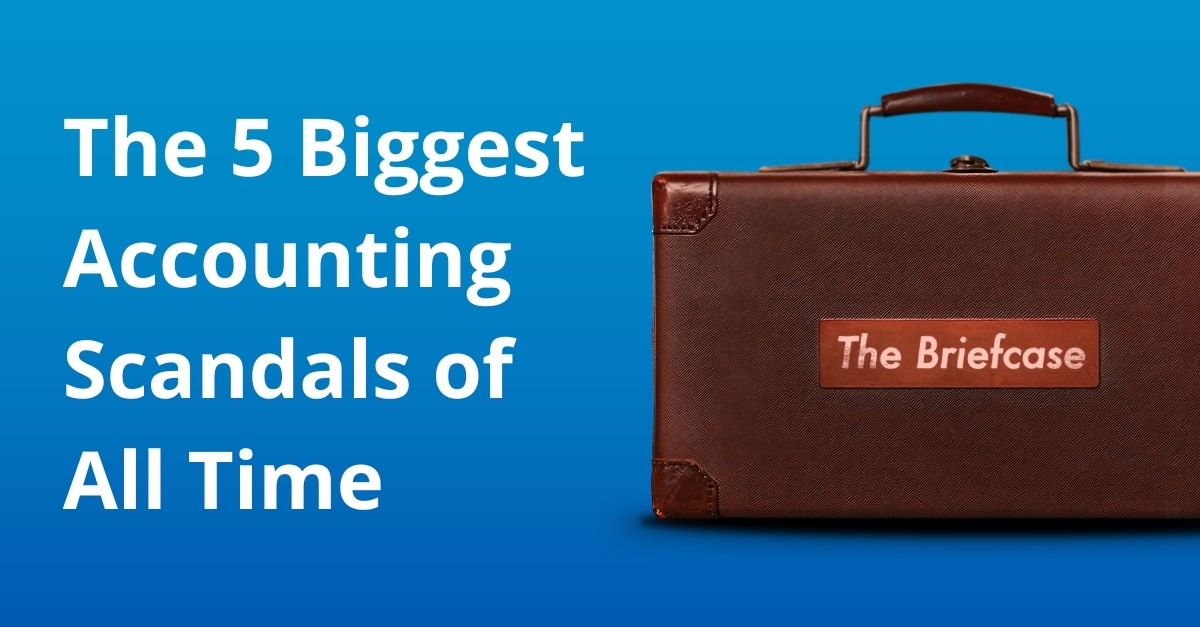For most of us, the biggest scandals our office will be involved in is whether Aidan turned the dishwasher on before he left, or if Chloe ate the last Hobnob. But, believe it or not, some accountants are involved in activity that’s downright criminal – whether that be through greed, negligence, or pressure from the top.
So, with the news that EY allegedly provided audit services to gambling firms with ties to the Triad, now's a good time to consider the murkier side of audit, and the nasty repercussions for some very bad behaviour.
This week, we’re opening the Briefcase on the five juiciest, most catastrophic, career-ending financial faceplants of all time – and what you, dear spreadsheet wrangler, can learn before your own foot ends up firmly in your P&L.
1. Enron (2001)
Once the darling of Wall Street, Enron wasn’t just cooking the books, it was serving them with steak frites. After all, who needs assets when you have vibes? They invented revenue with mark-to-market fairy dust and hid debts in a hydra of shell companies. By the millennium, Enron was reporting revenue of a staggering $100 billion – which amounted to an impossible 65% annual expansion over six years.
Basically, every year, Enron would announce that they had broken the basic realities of day-to-day business. When the business collapsed, their auditors, Arthur Andersen, collapsed along with them.
💡What You Can Learn: Getting too cosy with your client can cost you everything. Arthur Andersen wanted to keep the consulting fees, and just like that, the Big Five became the Big Four.
2. Wirecard (2020)
This German payment processor had all the good stuff – techy buzzwords, sharply dressed execs, and a suspicious €1.9 billion sitting in a bank account that didn’t exist. In yet another case of a Big Four company (this time EY) not asking enough questions and signing off on dodgy accounts for years, Wirecard fell in 2020.
A fun twist to the story is that EY became the main auditor for Wirecard in 2008 after performing an emergency audit for the company because – you guessed it – balance sheet irregularities.
💡What You Can Learn: Professional scepticism isn’t just a buzzword, it’s your job. EY’s failure to verify bank statements that amounted to €1.9bn is, at best, a bit too trusting.
3. WorldCom (2002)
While the C-suite was busy inventing phrases like "prepaid capacity” (translation: move expenses to the balance sheet and hope no one notices), Cynthia Cooper and her internal audit team were burning the midnight oil – literally – working nights to avoid detection while tracking down $3.8 billion in phantom entries.
Management’s response? Stall. Obstruct. Then ask: "Do you have to do this audit right now?”
Turns out yes. Yes, they did.
💡What You Can Learn: Internal audit isn’t just a checkbox, it’s the conscience of the company. Also, don’t fire the guy who warns you about tax fraud. Just a thought.
4. Lehman Brothers (2008
By 2008, Lehman had $680 billion in assets… backed by just $22.5 billion of capital – which might seem like your bank account after buying a bottle of olive oil on a credit card, but is somehow even worse.
The bank used Repo 105 to sweep toxic assets under the rug just long enough to keep investors, regulators and even its own board in blissful ignorance – at least that’s their story. But when real estate prices dipped just a few percent, all that capital left the same way it had entered – out of nowhere.
💡What You Can Learn: If your assets can be wiped out by a sneeze in the market, it’s not growth, it’s gambling.
5. Satyam (2009)
Satyam was a darling of Indian IT, until its chairman was forced to admit his role in inflating profits, faking assets (including over $1 billion in cash), and stuffing the payroll with employees who never showed up – not out of laziness, but because they straight up didn’t exist.
The move for Satyam’s higher-ups was to pump the share price long enough to pull off a family-friendly real estate deal. And they would’ve gotten away with it, if it wasn’t for the pesky 2008 property collapse.
💡What You Can Learn: Don’t fake the cash. Don’t fake the profits. Don’t fake anything!
Honourable mentions
Just outside the top five, but still worthy of an awkward cough in an audit committee meeting:
- Parmalat – faked $4bn in bank assets – that’s a parma-lot!
- Autonomy – sold at a high price to HP, before the latter noticed some "aggressive accounting”.
- Tesco – in 2014, Tesco booked supplier income before it actually existed. Every little helps!
- Olympus – hid $1.7bn in losses for over a decade, before they came into focus.
- Carillion – a £7bn liability timebomb no one wanted to defuse.
🧠 Final Thoughts
As you might’ve noticed, some companies can move through a scandal, but it’s definitely worth avoiding – if at all possible. If you're tempted to "just tweak the numbers,” ask yourself: would I want this showing up in a Financial Times exposé, featuring my headshot next to the phrase "unprecedented accounting failure”? If the answer to that question is yes, then by all means, go ahead.
🎓 Want to stay off this list? Ethics and professionalism are your new best friends. Check out all our CPD here!

You need to sign in or register before you can add a contribution.